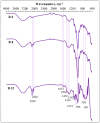Innovative Hemp Shive-Based Bio-Composites, Part II: The Effect of the Phase Change Material (PCM) Additive on Characteristics of Modified Potato Starch Binders
- PMID: 40004414
- PMCID: PMC11857691
- DOI: 10.3390/ma18040891
Innovative Hemp Shive-Based Bio-Composites, Part II: The Effect of the Phase Change Material (PCM) Additive on Characteristics of Modified Potato Starch Binders
Abstract
This study investigates the effect of phase change materials (PCM) on the properties of modified potato starch binders and hemp shive-based bio-composites, emphasizing their potential for sustainable construction applications. PCM-modified binders have shown reduced viscosity during gelatinization, enhancing their workability and uniformity during processing. A microstructural analysis reveals that PCM addition results in a denser and more cohesive binder network, leading to improved adhesion and reduced porosity. A thermal analysis demonstrates a shift to higher decomposition temperatures and a linear increase in specific heat capacity within the PCM phase-change range (20-30 °C), significantly enhancing the thermal storage capacity of the bio-composites. PCM addition improves compressive strength by up to twice, with optimal performance achieved at 8% PCM additive content. The prolonged cooling time, up to three times longer in bio-composites with PCM additive, highlights their effectiveness in thermal regulation. Additionally, bio-composites with a PCM additive exhibits increased bulk density and reduced water swelling, improving dimensional stability. These findings underline the dual benefits of enhanced thermal and mechanical performance in bio-composites with a PCM additive, making them a viable alternative to conventional building materials.
Keywords: bio-composite; bio-composites; hemp shives; phase change materials; potato starch binder; sustainable building materials.
Conflict of interest statement
The authors declare no conflict of interest.
Figures












Similar articles
-
Innovative Hemp Shive-Based Bio-Composites: Part I: Modification of Potato Starch Binder by Sodium Meta-Silicate and Glycerol.Materials (Basel). 2024 Oct 8;17(19):4911. doi: 10.3390/ma17194911. Materials (Basel). 2024. PMID: 39410482 Free PMC article.
-
Insight into the Use of Brewers' Spent Grain as a Low-Carbon Aggregate in Building Materials.Biomimetics (Basel). 2024 Dec 21;9(12):781. doi: 10.3390/biomimetics9120781. Biomimetics (Basel). 2024. PMID: 39727784 Free PMC article.
-
Experimental Analysis of Moisture-Dependent Thermal Conductivity, and Hygric Properties of Novel Hemp-shive Insulations with Numerical Assessment of Their In-Built Hygrothermal and Energy Performance.Materials (Basel). 2024 Jan 19;17(2):486. doi: 10.3390/ma17020486. Materials (Basel). 2024. PMID: 38276425 Free PMC article.
-
Review of Solutions for the Use of Phase Change Materials in Geopolymers.Materials (Basel). 2021 Oct 13;14(20):6044. doi: 10.3390/ma14206044. Materials (Basel). 2021. PMID: 34683631 Free PMC article. Review.
-
Recent advances and future challenges of the starch-based bio-composites for engineering applications.Carbohydr Polym. 2023 May 1;307:120627. doi: 10.1016/j.carbpol.2023.120627. Epub 2023 Jan 28. Carbohydr Polym. 2023. PMID: 36781278 Review.
References
-
- Rathore P.K.S., Gupta N.K., Yadav D., Shukla S.K., Kaul S. Thermal Performance of the Building Envelope Integrated with Phase Change Material for Thermal Energy Storage: An Updated Review. Sustain. Cities Soc. 2022;79:103690. doi: 10.1016/j.scs.2022.103690. - DOI
-
- Elhamy A.A., Mokhtar M. Phase Change Materials Integrated Into the Building Envelope to Improve Energy Efficiency and Thermal Comfort. Future Cities Environ. 2024;10:9. doi: 10.5334/fce.258. - DOI
-
- Ürge-Vorsatz D., Cabeza L.F., Serrano S., Barreneche C., Petrichenko K. Heating and Cooling Energy Trends and Drivers in Buildings. Renew. Sustain. Energy Rev. 2015;41:85–98. doi: 10.1016/j.rser.2014.08.039. - DOI
-
- Sawadogo M., Godin A., Duquesne M., Lacroix E., Veillère A., Hamami A.E.A., Belarbi R. Investigation of Eco-Friendly and Economic Shape-Stabilized Composites for Building Walls and Thermal Comfort. Build. Environ. 2023;231:110026. doi: 10.1016/j.buildenv.2023.110026. - DOI
-
- Bumanis G., Bajare D. PCM Modified Gypsum Hempcrete with Increased Heat Capacity for Nearly Zero Energy Buildings. Environ. Clim. Technol. 2022;26:524–534. doi: 10.2478/rtuect-2022-0040. - DOI
LinkOut - more resources
Full Text Sources

